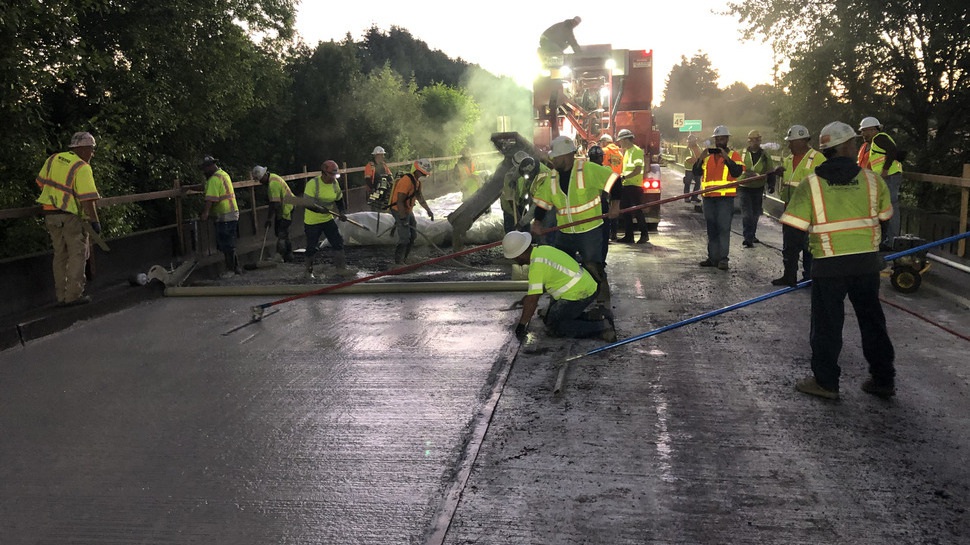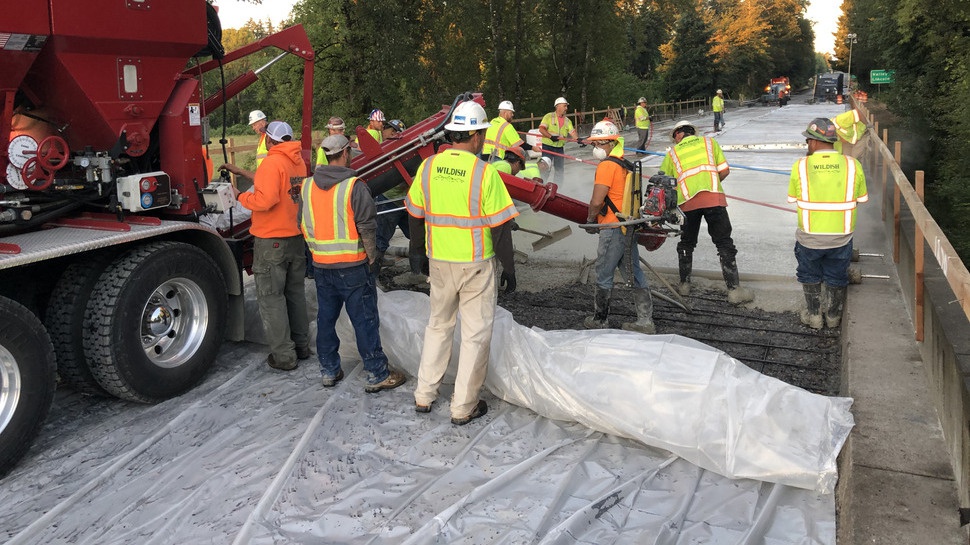
Running 60 miles eastward from the Pacific Coast to the outskirts of Portland, Highway 18 is one of Oregon’s most scenic drives. In addition to taking drivers through forests and farmland, the two-lane road winds through 800 vineyards scattered throughout the Willamette Valley. Wine country, in other words. Every year, millions of tourists spend almost $2 billion in the region.
With the road so critical to the state’s economy, the Oregon DOT (ODOT) is loath to close any portion of it. When maintenance must be done, it must be done quickly.
Located where two forks of the Yamhill River meet, the city of McMinnville is the heart of the McMinnville American Viticultural Area (AVA). When the reinforced concrete deck of the two-lane bridge over the river’s south branch required rehabilitation, a structural overlay was deemed necessary.
The state doesn’t consider polyester polymer concrete (PPC) to be a structural overlay because its modulus of elasticity is lower than concrete’s, so that eliminated PPC. The state also wanted to prepare the deck for the overlay via hydrodemolition, which doesn’t pair well with moisture-intolerant polyester.
Oregon DOT stopped using latex-modified concrete (LMC) decades ago in favor less-expensive silica fume concrete (SFC) overlays. However, SFC requires a seven-day cure – too long for the high-traffic bridge. Another alternative was high-performance concrete (HPC), a low-shrink, low-permeability concrete mix using silica fume or supplementary cementitious materials (SCMs) – but it, too, cures for seven days.
This was an opportunity to try something new: a very-low-permeability, high-early-strength concrete (HESC) mix made with Oregon’s only approved ASTM C1600 (Standard Specification for Rapid Hardening Hydraulic Cement) calcium sulfoaluminate (CSA) cement, Rapid Set® Cement.
To lower permeability, the cement would be dosed with Liquid Low-P™. The liquid admixture extends reinforced concrete life by increasing resistance to corrosives like chlorides – salts – in anti-icer and deicing solutions applied to roads before and after winter storms. In addition to lowering chloride ion penetrability to the state’s requirement of less than 1,000 coulombs (per ASTM C1202), the admixture further guards against corrosion by forming a protective coating around rebar.
At 10 ounces per every 100 pounds of cement, half a gallon of admixture is required to produce 1 cubic yard of very-low-permeability concrete overlay.
Admixture Adds to Cement’s Advantages
Having used Rapid Set® products such as DOT Repair Mix, CR Concrete Resurfacer, Cement All®, and DOT Concrete Mix in other maintenance and repair applications, ODOT was familiar with the CSA cement’s benefits compared to portland cement.
As the name implies, Rapid Set® cures much faster with much less shrinkage cracking, minimizing entry points for water and chlorides. Per ASTM C1581 testing, portland cement-based high-early-strength concrete cracked in less than four days, whereas Rapid Set was crack-free at four months. Concrete made with the cement meets Oregon’s high-performance concrete shrinkage requirement of less than 0.045%.
Rapid Set® Cement doesn’t contain tricalcium aluminate (C3A), the mineral phase that makes portland cement susceptible to sulfate attack. Finally, its minerology makes it less prone to alkali-silica reaction (ASR) in the presence of reactive aggregate, expanding the range of aggregate that can be used in a concrete mix.
New Overlay Material, New Specification
The bridge was rehabilitated over two July weekends, one for each lane.
To remove the chlorides that had penetrated into the bridge deck, causing the reinforcing steel to corrode, Wildish Construction removed 1.5 inches of the existing reinforced concrete deck via hydrodemolition. The contractor then placed 2 inches of overlay produced and delivered by Nation’s Mini-Mix. The concrete mix contained ¾-inch aggregate. Water-to-cement ratio was 0.46.
After being leveled with a roller screed, the wet concrete was textured with a broom finish.
Because Rapid Set® is a ASTM C1600 very-rapid-hardening CSA cement, Oregon requires three hours of wet cure – another significant time savings. In this case, the contractor placed AASHTO M-182 burlap on the fresh concrete and saturated it with water via hose.
Required compressive strength was 4000 psi. Ultimately, Wildish Construction’s crews placed 56 cubic yards of the HESC mix over a 1,000-square-yard bridge deck area.
“We allowed 72 hours for each placement,” says ODOT Statewide Structural Materials Engineer David Dobson, PE. “This helped target optimal ambient temperature ranges for the placement. There was a lot of float in the schedule, but we finished well before then each time.”
A visual inspection two years later showed no rutting or delamination, and the state has used the structural overlay mix for other bridge projects since this initial placement. It is amending its HESC specification to require Liquid Low-P™ for permeability reduction.
